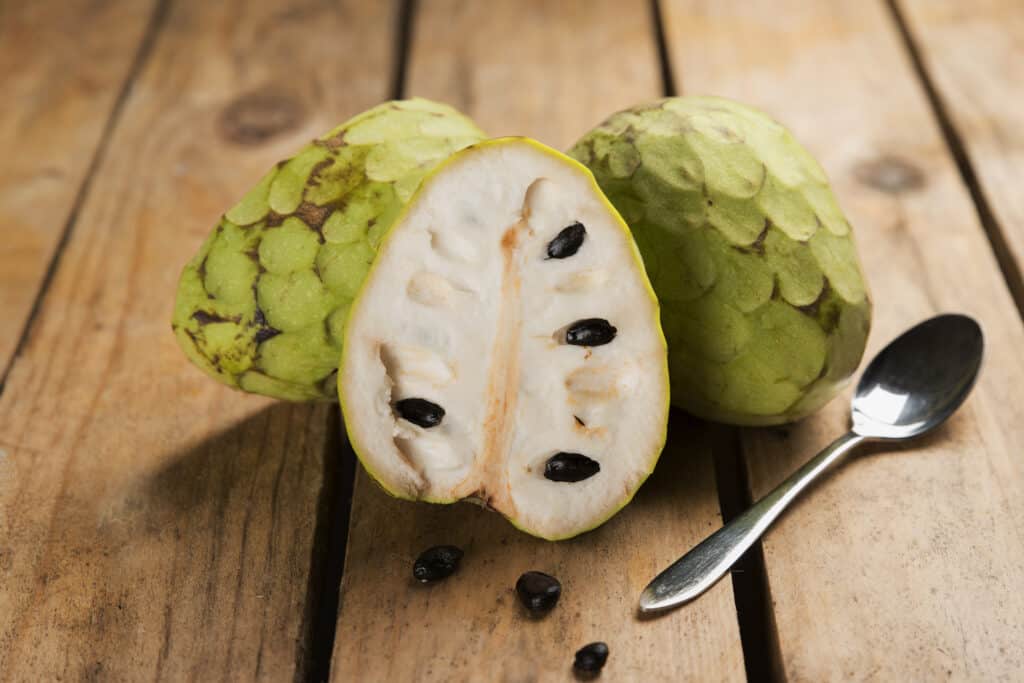Finding a new, intriguing fruit at the grocery store is always a joy. Luckily, there are so many options from around the world. And many of them are available in our local markets these days. So next time you swing past the tropical fruit section, look for cherimoya (Annona cherimola) or custard apples (Annona reticulata) for a real treat.
This article explores these two fruits. Continue reading to learn their similarities and differences.
Cherimoya vs. Custard Apple: Comparison
These two fascinating fruits share a common nickname — custard apple. So that can make it difficult to uncover their unique personalities and traits. Exploring specific characteristics to understand their differences is helpful, which you will find in the chart below.
Both cherimoya (Annona cherimola) and custard apple (Annona reticulata) belong to the Annonaceae family and Annona genus. There are approximately 200 species in the Annona genus and more than 2000 species in the Annonaceae family.
While cherimoya and custard apple come from the same family and share the same nickname, they are also starkly different. Some of the key differences are their origin, size, fruit, and growing requirements. Below, we examine each of these areas.
| Cherimoya | Custard apple | |
|---|---|---|
| Scientific Classification | Annona cherimola | Annona reticulata |
| Common Name(s) | Cherimoya, custard apple, anona | Wild sweetsop, custard apple, bullock’s-heart, sugar apple |
| Origins | Colombia, Peru, and Ecuador | West Indies |
| Size | This deciduous tree is relatively short in stature. It only grows between 19 and 32 feet tall. | This broadleaf evergreen can grow up to 35 feet high, with a span of up to 30 feet. |
| Fruit | The large, heart or cone-shaped green fruit can grow to a surprising 11 pounds each! And its edible flesh is white, fragrant, and juicy. | The fruit develops a yellowish-red to brown-colored skin. It reaches up to 5 inches in length and has white, creamy flesh. The fruit can weigh up to 2 pounds each. |
| Growing Requirements | It is winter hardy in Zones 8-12. The tree prefers sandy, clay, or well-draining loamy soil. And it does not need nutritionally rich soil. It is drought-tolerant and needs full sun. | They thrive in Zones 10-11 in full sun, although they can tolerate occasional partial shade. These trees need moist, rich, and well-draining soil. Additionally, they are extremely frost sensitive but will survive a brief dip below freezing. |
| Fun Facts | Do not eat the seeds or stems. They are extremely poisonous. | Its beautiful showy flowers alone are worth growing these trees. |
Cherimoya vs. Custard Apple: Origin
The cherimoya fruit is native to Ecuador, Peru, and Colombia. But its cousin, the custard apple, is native to the West Indies.

Custard apples are native to the West Indies.
©jatmika jati/Shutterstock.com
Cherimoya vs. Custard Apple: Size
Cherimoya trees are relatively short deciduous trees. They grow anywhere from 19 to 32 feet in height.
However, custard apple trees typically grow much larger. The broadleaf evergreens are 35 feet tall and develop an almost equivalent span. Their branches reach up to 30 feet across.
Cherimoya vs. Custard Apple: Fruit
The delicious cherimoya fruit has white and juicy flesh that smells almost as good as it tastes. While most develop to around the size of a grapefruit, the fruit can get up to an amazing 11 pounds. Their exterior is a lovely green, and they sport a cone or heart shape. The trees are propagated more for the tasty fruit than anything. You can eat them straight or incorporate them into drinks and desserts.
On the other hand, custard apples are slightly smaller. They grow up to roughly 5 inches long and 2 pounds in weight. The skin varies between brown and yellowish-red, while the flesh is a luscious white. Unfortunately, custard apples are not known for their consistent flavor profile. You may get some with a divine flavor, while others do not taste good. So the trees are primarily grown as ornamentals rather than for fruit.

Cherimoya fruit has creamy, white inner flesh.
©Fabio Di Natale/Shutterstock.com
Cherimoya vs. Custard Apple: Growing Requirements
Thankfully, lovely cherimoya trees are relatively easy to grow in Zones 8-12. They are not frost tender, need full sun, and are not picky about their soil. You can successfully plant the trees in sandy, loamy, or clay soil. And you do not need to worry about the nutritional requirements. However, their soil should be well-draining and kept moist. Additionally, this lovely tree is drought-tolerant.
In contrast, custard apple trees have a more restrictive range where they are winter hardy. You can grow these trees outside in Zones 10-11. They need nutritionally rich soil that is kept moist and well-draining. Unfortunately, they are very frost sensitive. But one or two nights that dip below freezing won’t usually hurt them.
Thank you for reading! Have some feedback for us? Contact the AZ Animals editorial team.








